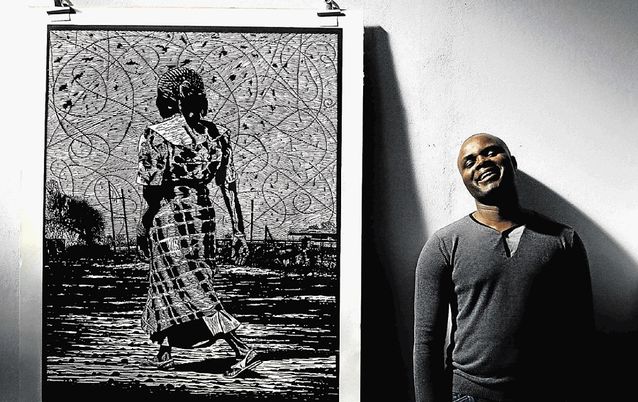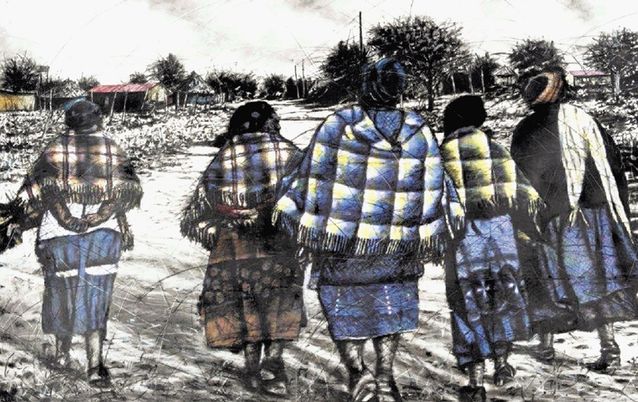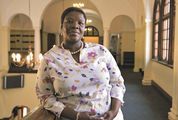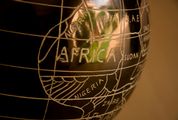Picturing the arc of life from rural to urban
by Edward Tsumele,
2016-03-04 05:00:00.0
AT EXACTLY 10am, the time set for my meeting with artist Phillemon Hlungwani, I receive a call. He’s going to be late, he apologises. There’s an accident on Johannesburg’s Oxford Road.
This might look like unnecessary detail, but it reveals a quality that is rare among artists: a consciousness of time and its importance in a vocation that is increasingly becoming a business.
"Art needs someone to be disciplined," says Hlungwani.
"For this exhibition, I worked every day last year.… It was a real challenge for me."
He is speaking of the solo exhibition, From Giyani to Alexandra: The Journey Continues, that opened yesterday at Circa Gallery, the Everard Read’s contemporary art space in Rosebank, Johannesburg. He has made two of everything, replicating each art work on display, detail by detail, for an exhibition at the Gallery Grande Provence in Franschhoek in the Western Cape winelands, starting on Sunday.
"The creation of these works needed a lot of concentration," says Hlungwani. "Even if the brush strokes are not the same, and they will never be the same, at least when you look at the twin art works, they must tell you that they are the same. At least the figures must look the same."
Hlungwani says he has always aimed at one thing: not disappointing himself. "A lot of artists say that when they create works they aim at not disappointing art buyers. I do the opposite, and that is not disappointing myself. If I like the works that I create, the chances are that art collectors will like them too."
Giyani to Alexandra: The Journey Continues, is autobiographical. Hlungwani has moved from the simple life of Thomo village, just outside Giyani, Limpopo, to the madness of the Johannesburg township, Alexandra. He says he has found similarities between the two. People in both places have a sense of fashion amid poverty, and are embroiled in the continual struggle for financial security and personal success.
"The exhibition is story telling about where I come from, Thomo village to Alexandra. Both places give me inspiration in that it looks like for one to succeed, just as I have done, you need to come from humble beginnings to a place like Alexandra where there is poverty everywhere, but people have big dreams. And just like back home in Thomo village, somehow the people of Alexandra have dreams, and some achieve their dreams, while others do not. Both places inspire me," he says.
IF A person could come from a rural village, Qunu, in the Eastern Cape, live in Alexandra for a bit and then go on to be president, as did Nelson Mandela, anyone can do the same, he argues.
"Just before I started working on this exhibition, I had an exhibition about Qunu at the Everard Read Gallery, dedicated to Mandela, and how he found himself living in Alexandra, just as I did.
"Alexandra is a place of humble beginnings, and yet artists and politicians have emerged from that place to take prominent roles in society," he says.
Although Hlungwani professes to love Alexandra and Thomo village equally, his works betray his greater affinity for Thomo. Most of his etchings show landscapes and figures of women in the village, working hard to put food on the table for their families.
"I draw a lot of inspiration from the women of Thomo, and how hard they work to provide for their families while their husbands are working in Johannesburg and only come home at Christmas time.
"The landscapes with shadows are a depiction of my time with elders dishing out advice back home in Thomo. Each time I go there, the elders always give me wisdom that you will never find in books. It is this wisdom that I portray in the landscape drawings," he says.
-

Phillemon Hlungwani. Picture: SUPPLIED
-

Ndlela hi komba hi lava va nga rhanga va yi famba. I (Version 1): ‘The old people can show us where to go because they have experienced it before.’ Picture: CIRCA
-

Ku xonga ka nwansati i mi ntirho leyi nene. II (Version 1): ‘Women show their beauty through what they do’. Picture: CIRCA
AT EXACTLY 10am, the time set for my meeting with artist Phillemon Hlungwani, I receive a call. He’s going to be late, he apologises. There’s an accident on Johannesburg’s Oxford Road.
This might look like unnecessary detail, but it reveals a quality that is rare among artists: a consciousness of time and its importance in a vocation that is increasingly becoming a business.
"Art needs someone to be disciplined," says Hlungwani.
"For this exhibition, I worked every day last year.… It was a real challenge for me."
He is speaking of the solo exhibition, From Giyani to Alexandra: The Journey Continues, that opened yesterday at Circa Gallery, the Everard Read’s contemporary art space in Rosebank, Johannesburg. He has made two of everything, replicating each art work on display, detail by detail, for an exhibition at the Gallery Grande Provence in Franschhoek in the Western Cape winelands, starting on Sunday.
"The creation of these works needed a lot of concentration," says Hlungwani. "Even if the brush strokes are not the same, and they will never be the same, at least when you look at the twin art works, they must tell you that they are the same. At least the figures must look the same."
Hlungwani says he has always aimed at one thing: not disappointing himself. "A lot of artists say that when they create works they aim at not disappointing art buyers. I do the opposite, and that is not disappointing myself. If I like the works that I create, the chances are that art collectors will like them too."
Giyani to Alexandra: The Journey Continues, is autobiographical. Hlungwani has moved from the simple life of Thomo village, just outside Giyani, Limpopo, to the madness of the Johannesburg township, Alexandra. He says he has found similarities between the two. People in both places have a sense of fashion amid poverty, and are embroiled in the continual struggle for financial security and personal success.
"The exhibition is story telling about where I come from, Thomo village to Alexandra. Both places give me inspiration in that it looks like for one to succeed, just as I have done, you need to come from humble beginnings to a place like Alexandra where there is poverty everywhere, but people have big dreams. And just like back home in Thomo village, somehow the people of Alexandra have dreams, and some achieve their dreams, while others do not. Both places inspire me," he says.
IF A person could come from a rural village, Qunu, in the Eastern Cape, live in Alexandra for a bit and then go on to be president, as did Nelson Mandela, anyone can do the same, he argues.
"Just before I started working on this exhibition, I had an exhibition about Qunu at the Everard Read Gallery, dedicated to Mandela, and how he found himself living in Alexandra, just as I did.
"Alexandra is a place of humble beginnings, and yet artists and politicians have emerged from that place to take prominent roles in society," he says.
Although Hlungwani professes to love Alexandra and Thomo village equally, his works betray his greater affinity for Thomo. Most of his etchings show landscapes and figures of women in the village, working hard to put food on the table for their families.
"I draw a lot of inspiration from the women of Thomo, and how hard they work to provide for their families while their husbands are working in Johannesburg and only come home at Christmas time.
"The landscapes with shadows are a depiction of my time with elders dishing out advice back home in Thomo. Each time I go there, the elders always give me wisdom that you will never find in books. It is this wisdom that I portray in the landscape drawings," he says.

























Change: 0.83%
Change: 0.93%
Change: 0.95%
Change: 0.73%
Change: 1.91%
Data supplied by Profile Data
Change: 0.58%
Change: 0.49%
Change: 0.83%
Change: 0.00%
Change: 0.53%
Data supplied by Profile Data
Change: -1.42%
Change: -0.79%
Change: -0.44%
Change: -0.86%
Change: -0.12%
Data supplied by Profile Data
Change: 2.27%
Change: 2.09%
Change: 2.23%
Change: 2.47%
Change: 3.62%
Data supplied by Profile Data